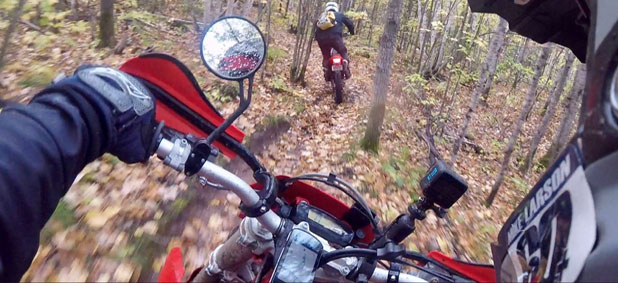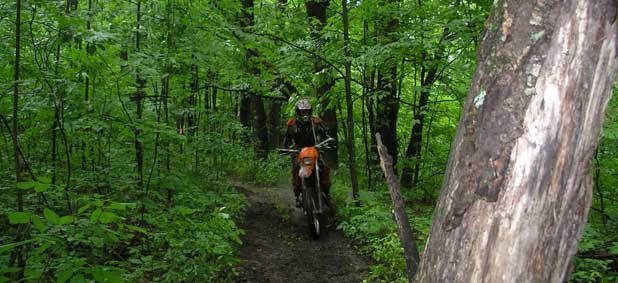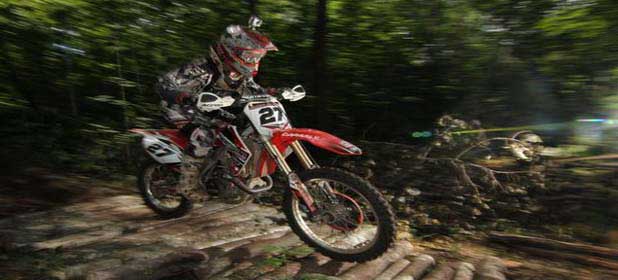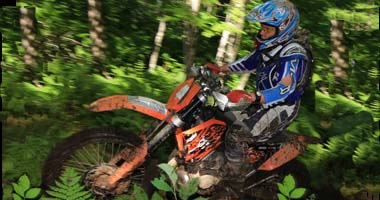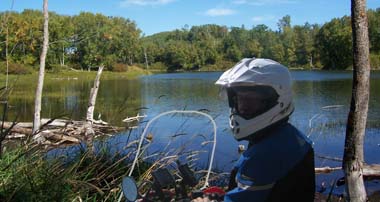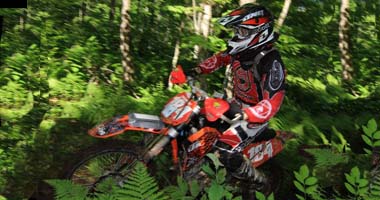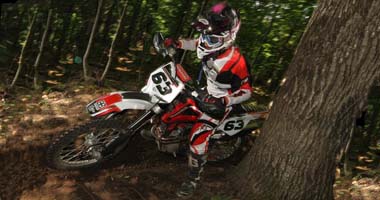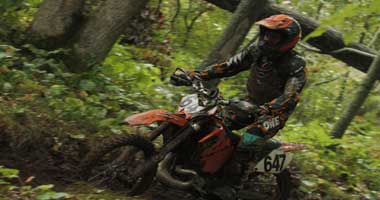What is an Enduro and what makes it different from a Hare Scrambles?
Hare Scrambles races start like a motocross with everyone in an individual class starting at once, and all the different classes starting one minute apart. Everyone rides laps around a trail for usually two (2) hours based on the leader. The rider doing the most laps wins, and you are riding as fast as you can the entire time.
Enduro's start four (4) riders at a time, one minute apart, starting at key time. Different class riders can ride together on the same minute. Each rider races against a pre-defined scheduled mph average and attempts to maintain a perfect schedule throughout the event. The thing that makes an Enduro interesting, and sets it apart from other dirt racing events, is the timekeeping. A rider is tasked with riding a set mile per hour average over varying terrain and given penalty points based on his/her being late or early to secret checkpoints along the course. Checkpoint crews know exactly the minute and second each rider is expected to arrive at any given mileage on the course, and they write it on a score card that is taped to the riders front fender.
The rider at the end of the race with the least amount of points, wins.
Enduro races usually take longer to ride and cover more ground miles than Hare Scrambles. Since every rider is racing against a schedule, the passing in the woods is a bit more respectful since the guys in your class could be spread anywhere along the course. In a perfect Enduro, if all riders were "on time", no one would have a reason to pass anyone. Also, in these longer events, the race promoters have the ability to give the riders rest periods by using mileage resets and free time.
Enduro's and Hare Scrambles are both fun, but Enduro racing adds the excitement of having a good, hard day of racing and riding with friends, with some cranial exercises added.
Do I really want to invest a lot of money into timekeeping gear?
No. You have already bought a dirt bike with a value equivalent to a great vacation to Disneyland for the family. You do have to invest a little bit for timekeeping the cheapest of which are outlined below. Luckily for you, Florida is home to the famous Alligator Enduro, so you can lump all the family activities together on that next vacation trip.
TIMEKEEPING FOR FREE
You can get by with no timekeeping equipment for your first Enduro if necessary. Arrange to get on a row with a rider who has timekeeping equipment. Assuming that you are staring this cold, and you are much faster than your buddy who talked you into this, you don't want him keeping time for you. So, you don't have to do timekeeping your FIRST race, just key off of a rider who is at least as fast as you in the woods, and is an experienced timekeeper. . . locate an elusive A rider.
At signup, you can tell them this is your first Enduro and you would like to be on a minute with a seasoned rider. More than likely, they will assign you a late number so you don't get in the way too much and they will put you on a minute with and A or B rider who can do your timekeeping for you. If they won't do this for you at signup, pick anyone from the row you are assigned which might be at the same riding level as you.
You will be assigned a ROW (minute) number, which is the number of minutes past the race start key time that your row will leave the starting line. At the starting line, memorize everything about the rider you are timekeeping from and DO NOT PASS THIS RIDER ALL DAY. It is that simple.
More than likely, you will only see that rider a few times during the race, if you're lucky, where the event promoter is giving the riders a breather at a gas stop, a reset, a free time, or in a slow section, and you manage to catch up, out of breath, wondering how late you are. Inevitable, just as he is (and so should you be) pulling out for the next section.
This works for your first Enduro but, it's a good idea to at least give a little thought about timekeeping for yourself just in case there isn't a rider of equal ability on your minute at the next event. Consider the next suggestion.
TIMEKEEPING FOR CHEAP
To do timekeeping on a budget for your next race you will need an ODOMETER, a WATCH (or two), and a ROLL CHART given to you at signup showing a list of possible secret checkpoints. The watch and odometer give you the ability to tell what mileage you are at and how much time has elapsed since you started the race. The roll chart lists the mileage and key time (minute) of all the possible checkpoints along the course.
ODOMETER
You can use the mechanical odometer that comes standard on most motorcycles, or you can buy an electronic odometer that has a magnetic pickup you attach to your front wheel.
The odometer needs to be able to show both miles, and tenths of miles, and be capable of being advanced to a new mileage during the event to accommodate resets. A cheap magnetic bicycle odometer runs about $12-$50 depending on the quality, features and size. Most Enduro riders use odometers designed for Enduro's. They provide the rider with the ability to enter in the mileage resets in advance of the event, which prevents them having to watch carefully for the mileage reset markers on the course and manually entering the new mileage marker into their odometer. These Enduro odometers can be pretty pricey, but well worth the money when you become competitive.
CLOCK
You will need a watch or a clock showing both minutes and seconds mounted to your handlebars. Buy a cheap plastic sports watch and securely mount it where you can easily see it while riding.
The next step up in investment is another $12.00 for a small box with a clear cover that is durable enough to mount on your handlebars. (An old roll chart holder with the reels removed works best.) Get two big digital LCD clocks mounted with Velcro® inside that old roll chart holder for $5.00 each. Set both at your minute, and set them up to display the time in hours and minutes on one and seconds on the other. Two clocks gives you a backup in case one fails. Take your row number and subtract that number of minutes from the current (key) time which is posted by the promoting club and set your clocks to that time. The promoter's key time is the master clock and is usually on display at signup the morning of the event, so this is one of the things you need to have time to do the morning of the Enduro before the race starts.
ROLL CHART HOLDER
You will need a roll chart holder which will hold a length of adding machine tape sized paper. You need to be able to roll the chart on a reel and look through a window to check your mileage against your clock during the event to make sure you are on time. You can get a roll chart holder at any off-road bike shop. They cost about $10-$15 depending on the manufacturer. Some have rubber around the edges to help keep your roll chart dry, but be sure to tape even these models as the rubber can be easily tore off during an event. They are simple to use. Just tape the roll chart together at the race so it is a continuous length of paper wide enough to fit inside the holder. Tape the bottom of the roll chart to the bottom reel in the holder and roll the chart onto the reel. Tape the top of the roll chart to the top reel and seal the box with tape so it doesn't leak. As you roll down the course, you can watch your mileage on your odometer, roll up your roll chart, match up the mileage, and check the clock against the roll chart to see if you are on time.
Now put this simple timekeeping system to work. Put the roll chart in your chart holder, and make sure you can read it easily. Find the key time clock and set your clocks so when your minute comes up, your clock will read :00. For example, say your starting ROW number is 43. Set your clock 43 minutes behind the current key time. This will ensure your personal race will start at 9:00 a.m. (or whenever the promoter has established for key time) on YOUR clock, and your roll chart will match your clock no matter what row you are on. Genuine Enduro clocks are nothing but timers, so when you start them they automatically start at zero. Set your odometer to 00.0 on the starting line, and you are ready to go.
COMPUTERS
Some people think you have to buy a computer to race Enduro's. This is not the case. A roll chart, a clock, an odometer, and eyes not too blurry from crashes and mud suffice. Many Enduro riders buy computers as backup and enhancements so they can concentrate a little more on the course.
If you have decided that Enduro racing is the greatest thing, you can invest in the "all in one" computer. These computers do all the computing and mileage time comparison for you and you can still continue using the roll chart, odometer, and clock system as a backup.
These small computers mount on the handlebars and they have a single display for the rider to reference during the event. The rider enters all the course information, mileage advances, speed average changes, free times, gas stops, etc. into the computer before starting the event. A single button push on the computer during the event can switch the display from a simple "go slower, go faster, on time" display to a speedometer, an odometer, distance to the next possible checkpoint, and other features.
The features of a computer depend on the manufacturer of the computer and there are several. Some brands include PACEMAKER, ICO Racing, and the budget but very capable WATCHDOG.
How do I go about entering and getting ready to ride an Enduro?
Join the American Motorcyclist Association - You must be a full AMA member in good standing to compete in any type of AMA amateur competition. If you are not already a current AMA member, you may join at the event or call the AMA Membership Services Department at 800-AMA-Join. Keep your receipt and take it with you to future events, as it will serve as your proof of membership until you receive your permanent AMA card. If you don't receive your membership card within five (5) weeks of joining, call the Membership S services Department at 1-800-AMA-JOIN.
You will be required to agree that you will not sue the AMA or the organizer, and at each event you will be required to sign statements releasing the AMA and the organizer from any indemnity.
Join your local AMA District - In Minnesota this is District 23. You can join District 23 by mail or at an event. Visit the District 23 website for more information on how to join.
All participants and spectators attending an event may be required to pay an admission fee upon entering the facility. Race participants normally must also pay a registration or entry fee in addition to the admission fee.
All participants must wear a protective helmet, eye protection, gloves, a long-sleeve shirt, protective pants, and boots that are at least eight (8) inches high.
READ THE RULES!!
It is your responsibility to know the rules. Become familiar with the AMA rulebook. The rulebook is published each year in the March issue of the American Motorcyclist magazine an can also be downloaded from the AMA web site.
PREPARE
Prepare your bike and your body for the event. Make sure your protective gear provides adequate protection for a challenging trail ride and will protect your body such that you can get up after a crash and continue down the trail. A DOT approved helmet is an absolute MUST. You cannot compete in an Enduro without one. Good off-road boots, face protection and good goggles for eye protection, good gloves, good gloves, a chest protector, knee and shin guards, and a kidney belt are also imperative if you want to minimize the amount of groaning you will be doing at the end of the event.
If you have relatives in Egypt of the dromedary family, you will not need water, but if you think you might get a little thirsty in three (3) to five (5) hours of hard riding, strap on a plastic water bottle to the back of your chest protector with zip ties or on your fanny pack belt. Fasten a length of 3/8" tubing to the water bottle and run it up to your mouth.
All of this equipment listed is really minimum requirements.
Your trusty metal steed needs to be exactly that. Check your brakes and clutch for wear, lubricate all your cables and levers well, and make sure your timekeeping equipment is reasonably waterproof. Enduro event organizers cannot predict the weather, so they usually route you through any water they can find so you get some kind of bath and do not offend too many sensitive noses coming off the trail.
Make sure you have lever guards on your bike (bark busters) and if you can tolerate it, cut your handlebars down so they are about 30" wide. There are typically a couple of tight sections at Enduro's. Make sure you have plenty of gas along in two containers, one for the main gas and one to put out at any gas available stops along the course. Most event organizers will make gas available stops along the course, but you lose time stopping to gas up at anything other than an official gas stop. Buy a fanny pack, even a small cheap one will do to carry common tools and a spark plug.
PICK AN EVENT TO RIDE
Usually the course marshal's(the guys who lay out the course) are grizzled seasoned riders who enjoy hanging around the scoring table and are known to mutter phrases like "Why do you think they are called endurance races?" Typical Enduro's consist of a route through wooded areas over trails, dirt roads and some paved roads. Because some public roads are used, riders must be licensed and their machines must be legal for highway use. If the course covers public lands, you are required to have a spark arrestor and your bike will have to pass sound testing. Some are "closed course" events and only require a spark arrestor. Events utilizing public roads may require passing a technical inspection to make sure your bike meets the requirements of a street legal motorcycle. Do not let this discourage you, since this is the most fun you will ever have on a motorcycle and well worth the effort.
HAVE FUN
Enjoy your first Enduro, and just try to finish. Whether you burn a few checks, or almost hour out with a flat or no breaks, you will be tickled pink with yourself to be able to say you finished the race. It's always a fun ride no matter how you slice it, and more a test of yourself, than a race against another rider.
